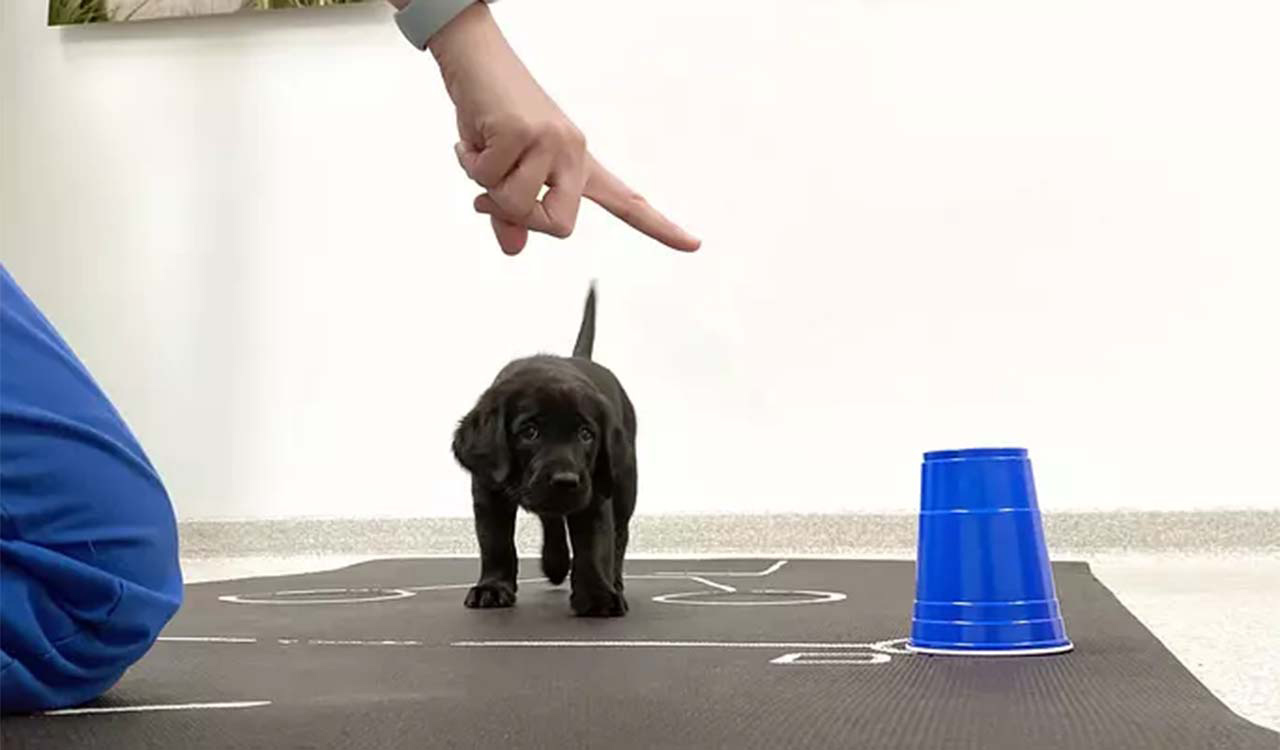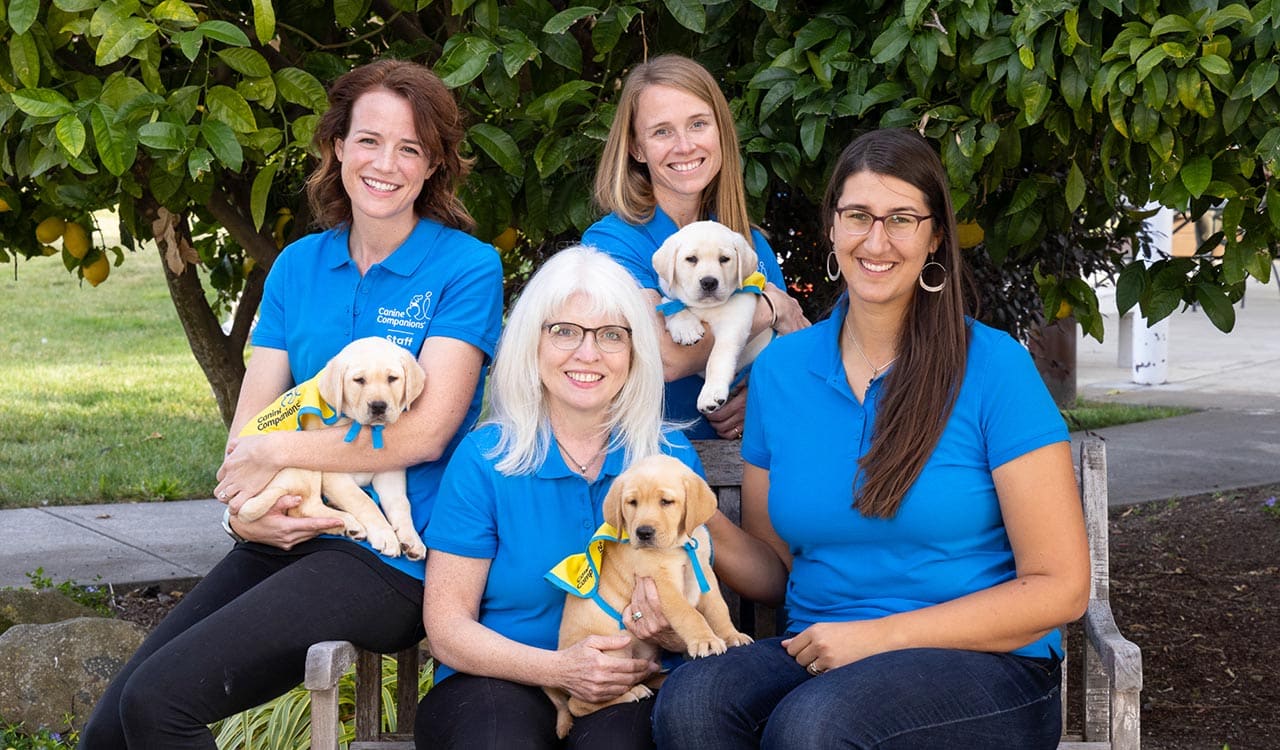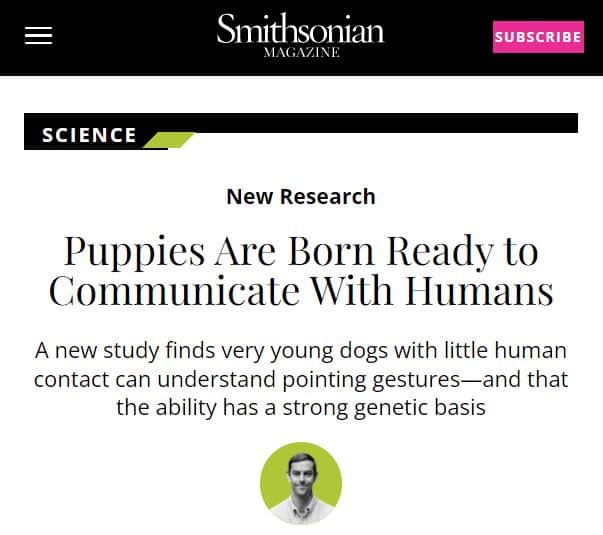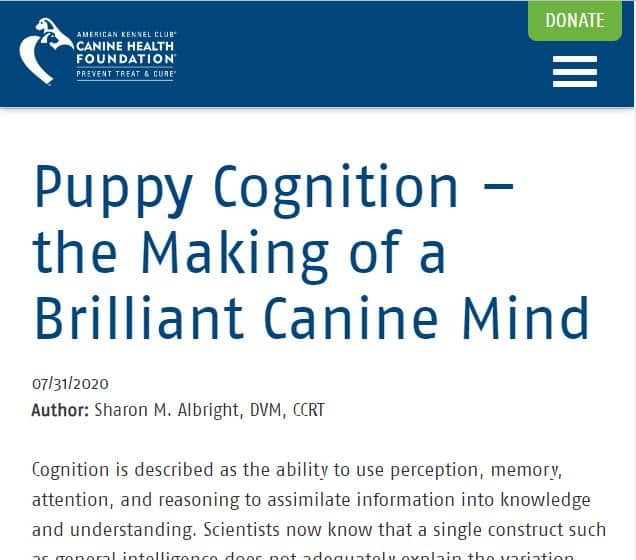Presentations and Publications
Highlights:
A new study finds very young dogs with little human contact can understand pointing gestures—and that the ability has a strong genetic basis.
The AKC Canine Health Foundation (CHF) and its donors have invested in ground-breaking research to explore the cognitive abilities of our canine companions – particularly those that work closely with us as detection dogs, service dogs, assistance dogs, and more.
Dogs are born ready to communicate with humans, according to a new study involving hundreds of 8-week old puppies.
Presentations:
Our research team and collaborators share their expertise in canine research for our community and the public in various presentations. These presentations allow us to show how our work can impact our programs and provide benefits and greater success not only for our dogs, but also for our clients and the disability community.
Duke Puppy Kindergarten:
Canine Companions Facebook Live research update:
Dogged Justice podcast on puppy cognitive research:
Publications:
NOTE: Some publications are available for the public to download without payment. These are indicated below by the addition of [OPEN ACCESS] at the end of the citation.
Canine Companions, along with its collaborators from various research programs, publish findings that highlight our understanding of canine health, behavior and the impact of dogs on the human animal bond. We are proud to be a leader in the service dog industry. By publishing results in peer-reviewed journals, our research benefits the dog community at large as well as other organizations working to help individuals with disabilities lead more independent lives. Here’s a list of publications that the Canine Companions research team and/or data has contributed to.
- *Gnanadesikan, G. E., Tandon, D., Bray, E. E., Kennedy, B. S., Tennenbaum, S. R., MacLean, E. L., & vonHoldt, B. M. (2023). Transposons in the Williams–Beuren Syndrome Critical Region are Associated with Social Behavior in Assistance Dogs. Behavior Genetics. https://doi.org/10.1007/s10519-023-10166-7
- *Leighton, S. C., Rodriguez, K. E., Nieforth, L. O., & O’Haire, M. E. (2023). Service dogs for autistic children and family system functioning: a constant comparative analysis. Frontiers in Psychiatry, 14. https://doi.org/10.3389/fpsyt.2023.1210095 **
- *ManyDogs Project, Algergenia D., Bray, E. et al. (2023). ManyDogs Project: A Big Team Science Approach to Investigating Canine Behavior and Cognition. Comparative Cognition & Behavior Reviews. https://doi:10.3819/CCBR.2023.180004 ** [Open access]**
- *Salomons et al. 2023. Response to Hansen Wheat et al.: Additional analysis further supports the early emergence of cooperative communication in dogs compared to wolves raised with more human exposure. Learning & Behavior. https:// doi: 10.3758/s13420-023-00576-2 **
- Richerson, J. T., Wagner, T. H., Abrams, T., Skelton, K., Biswas, K., Illarmo, S., McSherry, F., Fallon, M. T., Frakt, A., Pizer, S., Magruder, K. M., Groer, S., Dorn, P. A., Huang, G. D., & Stock, E. M. (2023). Therapeutic and Economic Benefits of Service Dogs Versus Emotional Support Dogs for Veterans With PTSD. Psychiatric Services. https://doi.org/10.1176/appi.ps.20220138 **
- Bussolari, C., Currin-McCulloch, J., Packman, W., Kogan, L., & Erdman, P. (2022). The Loss of a Service Dog Through Death: Experiences of Partners. Illness Crisis and Loss. https://doi.org/10.1177/10541373221113336 **
- Currin-Mcculloch, J., Bussolari, C., Packman, W., Kogan, L., & Erdman, P. (2022). The Loss of a Service Dog Through Retirement: Experiences and Impact on Human Partners. Human-Animal Interaction Bulletin, 11(3), 39–53. [Open access]**
- Rudinsky, A. J., Parker, V. J., Winston, J., Cooper, E., Mathie, T., Howard, J. P., Bremer, C. A., Yaxley, P., Marsh, A., Laxalde, J., Suchodolski, J., & Perea, S. (2022). Randomized controlled trial demonstrates nutritional management is superior to metronidazole for treatment of acute colitis in dogs. Journal of the American Veterinary Medical Association, 1–10. https://doi.org/10.2460/javma.22.08.0349 **
- *Bray, E.E., Raichlen, D.A., Forsyth, K.K.. Promislow, D.E.L., Alexander, G.E., MacLean, E.L., & Dog Aging Project Consortium (2022). Associations between physical activity and cognitive dysfunction in older companion dogs: results from the Dog Aging Project. GeroScience. https://doi.org/10.1007/s11357-022-00655-8 **
- Byrne, C., Starner, T., Jackson, M. (2022). Quantifying canine interactions with smart toys assess suitability for service dog work. Frontiers in Veterinary Science. doi: 10.3389/fvets.2022.886941. [Open access]**
- *Bray, E.E., Zheng, Z., Tolbert, M.K., McCoy, B., Dog Aging Project Consortium, Kaeberlein, M., & Kerr, K.F. (2022). Once-daily feeding is associated with better health in companion dogs: Results from the Dog Aging Project. GeroScience. doi: 10.1007/s11357-022-00575-7. [Open access]**
- ManyDogs Project, Espinosa, J., Bray, E.E., Buchsbaum, D., Byosiere, S.E., Byrne, M., Freeman, M.S., Gnanadesikan, G.E., Guran, A., Horschler, D.J., Huber, L., Johnston, A.M., MacLean, E.L., Pelgrim, M.H., Santos, L., Silver, Z.A., Stevens, J.R., Völter, C.J., & Zipperling, L. (preprint; registered report accepted in principle). ManyDogs 1: A multi-lab replication study of dogs’ pointing comprehension. Animal Behavior and Cognition. doi: 10.31234/osf.io/f86jq. [Open access]**
- *Horschler, D.J., Bray, E.E., Gnanadesikan, G.E., Byrne, M., Levy, K.M., Kennedy, B.S., & MacLean, E.L. (2022). Dogs re-engage human partners when joint social play is interrupted: A behavioral signature of shared intentionality? Animal Behaviour, 183, 159-168. doi: 10.1016/j.anbehav.2021.11.007.
- Bray, E.E., Gnanadesikan, G.E., Horschler, D.J., Levy, K. M., Kennedy, B.S., Famula, T.R., & MacLean, E.L. (2021). Early-emerging and highly heritable sensitivity to human communication in dogs. Current Biology, 31(14), 3132-3136. doi: 10.1016/j.cub.2021.04.055.
- *Bray, E.E., Gruen, M.E., Gnanadesikan, G.E., Horschler, D.J., Levy, K. M., Kennedy, B.S., Hare, B.A., & MacLean, E.L. (2021). Dog cognitive development: a longitudinal study across the first 2 years of life. Animal Cognition, 24, 311-328. doi: 10.1007/s10071-020-01443-7.
- *Bray, E.E., Otto, C.M., Udell, M.A.R., Hall, N.J., Johnston, A.M., & MacLean, E.L. (2021). Enhancing the selection and performance of working dogs. Frontiers in Veterinary Science. 8:644431. doi: 10.3389/fvets.2021.644431. [Open access]**
- *Hall, N.J., Johnston, A.M., Bray, E.E., Otto, C.M., MacLean, E.L, & Udell, M.A.R. (2021). Working dog training for the twenty-first century. Frontiers in Veterinary Science, 8:646022. doi: 10.3389/fvets.2021.646022. [Open access]**
- *Kogan, L. R., Packman, W., Currin-McCulloch, J., Bussolari, C., & Erdman, P. (2021). The Loss of a Service Dog Through Death or Retirement: Experiences and Impact on Partners. Illness, Crisis & Loss, https://doi.org/10.1177/10541373211054168.** [Open access]**
- *Richerson et al. (2021). Randomized Trial of Differential Effectiveness of Service Dog Pairing Versus Emotional Support Dog Pairing to Improve Quality of Life for Veterans With PTSD. [Open access]**
- *Salomons, H., Smith, K., Callahan-Beckel, M., Callahan, M., Levy, K., Kennedy, B., Bray, E.E., Gnanadesikan, G., Horschler, D., Gruen, M., Tan, J., White, P., MacLean, E., & Hare, B. (2021). Cooperative communication with humans evolved to emerge early in domestic dogs. Current Biology, 31(14), 3137-3144. doi: 10.1016/j.cub.2021.06.051.
- *Bray, E.E., Gruen, M.E., Gnanadesikan, G.E., Horschler, D.J., Levy, K.M., Kennedy, B.S., Hare, B.A., & MacLean, E.L. (2020). Cognitive characteristics of 8- to 10-week-old assistance dog puppies. Animal Behaviour, 166, 193-206. doi:10.1016/j.anbehav.2020.05.019.
- *Bray, E.E., Levy, K.M., Kennedy, B.S., Duffy, D.L, Serpell, J.A., & MacLean, E.L. (2019). Predictive models of assistance dog training outcomes using the Canine Behavioral Assessment and Research Questionnaire and a standardized temperament evaluation. Frontiers in Veterinary Science. 6:49. doi: 10.3389/fvets.2019.00049. [Open access]**
- Petkov, E. P., Lesser, A. S., Lozier, S. M., Maguire, P. J., Fischetti, A. J., & Ahn, J. (2019). Radial torsion in dogs with medial compartment disease. Veterinary Surgery, 48(5), 869-877. https://doi.org/10.1111/vsu.13180.** [Open access]**
- MacLean, E. L., & Hare, B. (2018). Enhanced selection of assistance and explosive detection dogs using cognitive measures. Frontiers in Veterinary Science, 5, 236. https://doi.org/10.3389/fvets.2018.00236.** [Open access]**
- *Oberbauer, A. M., Daniels, R., Levy, K., Famula, T. R., Mundell, P., & Kelley, R. (2018). Maternal omega-3 polyunsaturated fatty acid supplementation on offspring hip joint conformation. PloS one, 13(8), e0202157. https://doi.org/10.1371/journal.pone.0202157.** [Open access]**
- *Holman, E., Levy, C., & Kennedy, B. (2018). Palliative Care Matters: Lessons From the Loss of a Facility Dog. American Journal of Hospice and Palliative Medicine®, 35(10), 1362-1364. https://doi.org/10.1177/1049909118761387.**
- *MacLean, E. L., Gesquiere, L. R., Gee, N., Levy, K., Martin, W. L., & Carter, C. S. (2018). Validation of salivary oxytocin and vasopressin as biomarkers in domestic dogs. Journal of neuroscience methods, 293, 67-76. doi: 10.1016/j.jneumeth.2017.08.033
- *Berns, G. S., Brooks, A. M., Spivak, M., & Levy, K. (2017). Functional MRI in awake dogs predicts suitability for assistance work. Scientific reports, 7(1), 1-10. [Open access]**
- *Cuscó, A., Belanger, J. M., Gershony, L., Islas-Trejo, A., Levy, K., Medrano, J. F., … & Francino, O. (2017). Individual signatures and environmental factors shape skin microbiota in healthy dogs. Microbiome, 5(1), 1-15. https://doi.org/10.1186/s40168-017-0355-6 ** [Open access]**
- *Isaiah, A., Hoffmann, A. R., Kelley, R., Mundell, P., Steiner, J. M., & Suchodolski, J. S. (2017). Characterization of the nasal and oral microbiota of detection dogs. PloS one, 12(9), e0184899. https://doi.org/10.1371/journal.pone.0184899.** [Open access]**
- *MacLean, E. L., Gesquiere, L. R., Gee, N. R., Levy, K., Martin, W. L., & Carter, C. S. (2017). Effects of affiliative human–animal interaction on dog salivary and plasma oxytocin and vasopressin. Frontiers in psychology, 1606. https://doi.org/10.3389/fpsyg.2017.01606.** [Open access]**
- *Breitenbuecher, C., Belanger, J. M., Levy, K., Mundell, P., Fates, V., Gershony, L., … & Oberbauer, A. M. (2016). Protein expression and genetic variability of canine Can f 1 in golden and Labrador retriever service dogs. Canine genetics and epidemiology, 3(1), 1-8. doi: 10.1186/s40575-016-0031-3 [Open access]**
- Krause-Parello, C. A., Levy, C., Holman, E., & Kolassa, J. E. (2016). Effects of VA facility dog on hospitalized veterans seen by a palliative care psychologist: An innovative approach to impacting stress indicators. American Journal of Hospice and Palliative Medicine®, 35(1), 5-14. https://doi.org/10.1177/1049909116675571 **
- *Bray, E.E., MacLean, E.L., & Hare, B.A. (2015). Increasing arousal enhances inhibitory control in calm but not excitable dogs. Animal Cognition, 18(6), 1317-1329. doi: 10.1007/s10071-015-0901-1.
- *Kelley, R., Levy, K., Mundell, P., & Hayek, M. G. (2012). Effects of Varying Doses of a Probiotic Supplement Fed to Healthy Dogs Undergoing Kenneling Stress. International Journal of Applied Research in Veterinary Medicine, 10(3). [Open access]**
- Duffy, D. L., & Serpell, J. A. (2012). Predictive validity of a method for evaluating temperament in young guide and service dogs. Applied Animal Behaviour Science, 138(1-2), 99-109. https://doi.org/10.1016/j.applanim.2012.02.011 **
- *Adams, W. M., Dueland, R. T., Daniels, R., Fialkowski, J. P., & Nordheim, E. V. (2000). Comparison of two palpation, four radiographic and three ultrasound methods for early detection of mild to moderate canine hip dysplasia. Veterinary Radiology & Ultrasound, 41(6), 484-490. https://doi.org/10.1111/j.17408261.2000.tb01875.x ** [Open access]**.
- Hart, J. (2002). Canine Companions for Independence (CCI) in hospice and bereavement: The benefits of a companion dog. Journal of Palliative Care, 18(3), 235.
* Canine Companions staff authorship on paper
**Please be aware that by clicking this link you are visiting sites that are not managed by Canine Companions. Website security, accessibility and privacy policies may be different than Canine Companions policies. Please read their policies closely.








